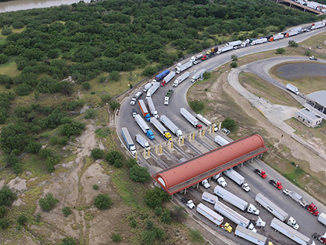In 1990, 4.5 million Mexicans lived in the U.S. In 2000, the number more than doubled to 9.75 million, and in 2008 it peaked at 12.67 million. This migration is not because so many millions of people are eager to leave their families behind in order to chase some dream in the U.S. In reality, U.S. economic policies in particular the North American Free Trade Agreement (NAFTA) of 1994, created this massive immigration by destroying Mexico’s economy.
In 1994, the Clinton administration passed NAFTA, which made Canada, Mexico and the U.S. a so-called “Free Trade Zone” that removed restrictions on international trade. The main purpose of NAFTA has been to provide cheap Mexican labor by displacing people from the countryside. And to create new markets for U.S. products in Mexico.
NAFTA removed many tariffs that protected local agriculture markets in Mexico while keeping the enormous subsidies for the U.S. agriculture industry paid for with our tax dollars. This gave a massive advantage for U.S. producers. For example, after NAFTA, U.S. corn was priced 19 percent below the cost of production, according to the Global Development and Environment Institute. Before NAFTA, corn was the largest crop in Mexico. NAFTA flooded the Mexican market with cheap U.S. corn, wiping out countless local producers. Corn imports from the U.S. rose from 2 million to 10.3 million tons from 1992 to 2008.
But NAFTA didn’t just destroy the Mexican corn industry. In 1995, the first year after NAFTA took effect, Mexico imported 30,000 tons of pork from the U.S. But by 2010, the amount of imported pork had increased more than 25 times, to over 811,000 tons, mostly all from the U.S. As a result 120,000 jobs were destroyed in the Mexican pork industry.
Another major piece of NAFTA was the privatization of communal land (ejidos). The Mexican military kicked tens of thousands of indigenous farmers off their land. Together these policies had a devastating effect upon people living in the countryside. Between 1992 and 1994, 35 percent of people lived in extreme poverty in rural Mexico, while between 1996 and 1998, the number jumped to 55 percent.
NAFTA was a conscious policy on the part of U.S. capitalists to force thousands of farmers to become low-wage workers in the U.S. For example, Smithfield Foods sent people to Mexico to recruit former pig farmers to work in their plant in North Carolina. These workers were paid below minimum wage and Smithfield management would use the government to organize deportation raids at any time.
U.S. corporations also take advantage of the cheap workforce in Mexico, building factories in towns along the border, called maquiladoras. The Mexican government enforces next to no safety, labor, or environmental protections. With the massive unemployment and desperate poverty imposed from NAFTA, these factory jobs attract workers, mainly young women, even though the pay is as low as $45 a week. Along with the poverty in these slums, there is a great deal of crime. One border city, Juarez, has one of the highest murder rates in the world as well as an epidemic of hundreds of women who have been raped and murdered.
Because it was known that the impact of NAFTA would greatly increase immigration into the U.S., just months after passing NAFTA, the Clinton administration passed “Operation Gatekeeper,” a bill to increase the militarization at the border, devoting billions of dollars to border security, doubling the number of Border Patrol agents, doubling the length of the border fence, and bringing in the latest surveillance. Since then, the passage along the border for migrants has become increasingly dangerous. Last year in 2012, there were 477 deaths reported along the border.
Today about twelve percent of Mexico’s population lives in the U.S. Mexican immigrants sent home $21.13 billion in 2010. Money sent home by these workers is now Mexico’s second-largest source of national income, behind oil.
The creation of an immigrant workforce, both legal and illegal, is no mistake. It is a conscious policy of the U.S. government. The purpose is to maximize the exploitation of Mexican workers both in Mexico and in the United States.




